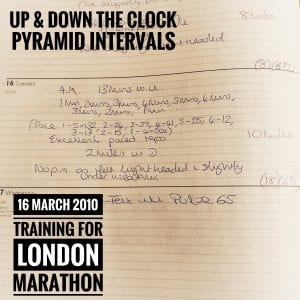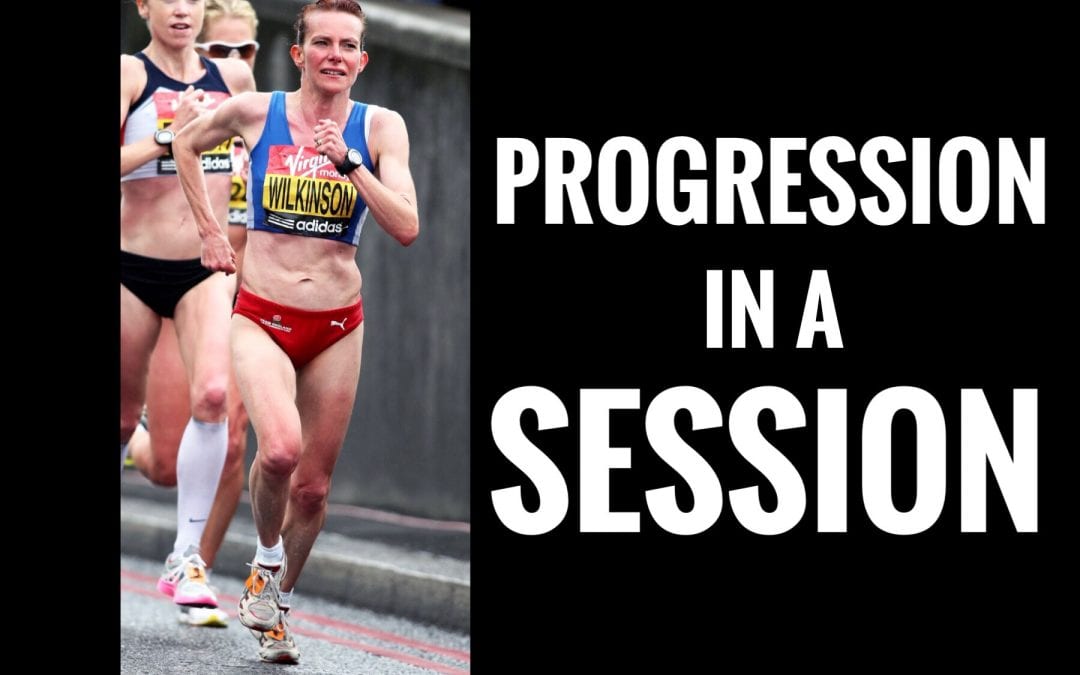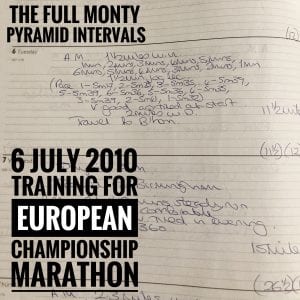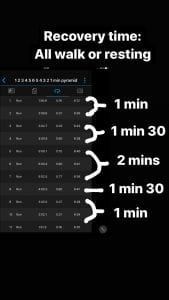Progression is the foundation of any successful training plan. The secret is to know how and when to develop the progression in a session to get the most from your training programme.
I illustrate how to build progression in a session with one of my favourite sessions as an elite athlete and coach – pyramid intervals.
The four key elements

My most recent Pyramid Intervals session
The four key elements of all training sessions are
- duration (length of reps)
- volume (number of reps)
- pace (how fast you run the reps)
- recovery (how much rest and what type of rest you get between each one)
Manipulation of these elements changes the nature of the session each time.
9 x 2 minutes reps are a different session to 15 x 2 minutes reps. But 9 x 2 minutes reps at 5k pace is equally different to 9 x 2 minutes reps at 10k pace.
Allow only 1-minute recovery for the 5k pace reps and it becomes a much harder session. Change the session to 3 sets x 3 x 2 minutes reps (with longer recovery between sets) and its more manageable. Then switch it up to 1-minute jog instead of resting recovery and you’ve increased the training load again.
Start from where you are now
One of the most common mistakes is to start with too much too soon. You need to make an honest assessment of your current fitness.
If the session is too long, too fast or has insufficient recovery, you will not be able to complete the whole session as intended. Potentially you don’t then get the desired adaption. Or worse, you get demoralised or overtrain. As a coach I love to challenge runners. But it’s also important to be uncompromising at times.
The key question is “Can you run the whole session at the pace and effort level required with the set recovery?” If the answer is clearly “no” then we build up the session progressively until you can.
Don’t rush progression
The second most common mistake is to add progression too quickly. It takes a minimum of eight weeks to start to see improvements in your aerobic and lactate energy systems. The timescales for physical changes are even longer. It’s two or three months for changes in muscles, tendons, ligaments and bones. Up to a year to develop physical changes to the density of your capillaries and mitochondria in muscles.
Progression in sessions should match these timescales. That means adding major progressions no more frequently than every four to six weeks to get the biggest training benefits.
Only change one element of the session each time. Either recovery, pace or number of reps. This will help you build fitness more effectively within your programme.
Progression in a Session – Pyramid Intervals
Pyramid intervals are one of my favourites as an athlete and coach. They are perfect to develop the progression of the session. The session aims to improve the pace and duration you can run above your lactate threshold and close to your lactate turning point. In essence, this sessions helps you to improve fitness and develop endurance and pace to run from 5km to 10km, half marathon up to marathon.
The Basic Session
6mins, 5mins, 4mins, 3mins, 2mins, 1min intervals.
2mins recovery
Many runners I coach will recognise this session. It has 21 minutes of quality work. It is good for base fitness, pace and for anyone aiming for 5kms. You should start the session by running at approx. 10km pace. That’s above your lactate threshold. Working hard, breathing heavily and able to answer in brief sentences at most. The effort and the pace should get faster as the reps get shorter and the recovery gets proportionately longer.
This session is front-loaded with three long reps at the beginning. It’s mentally challenging from the start. The good news is that after two reps you are already over half way through the intervals.
Start with resting recovery. Ideally at the end of the recovery your breathing should be more stable and you should be able to hold a conversation. As your fitness improves, change the recovery to walk and then to jog all whilst maintaining the pace of your reps.
Making progressions in the recovery before you increase the total volume of the session helps to improve your lactate processing capacity. This enables you to run closer to your lactate turning point for longer. An important ability for faster 5km and 10kms.
Up and down the clock
1min, 2mins, 3mins, 4mins, 5mins, 4mins, 3mins, 2mins, 1min intervals
2mins recovery
 This progression introduces the up and down the clock intervals. Intervals get longer before they get shorter. The overall volume is also greater at 25 minutes of quality work. This session starts to bridge the gap between 5km and 10km. It takes more fitness to run at the pace required for this extended volume.
This progression introduces the up and down the clock intervals. Intervals get longer before they get shorter. The overall volume is also greater at 25 minutes of quality work. This session starts to bridge the gap between 5km and 10km. It takes more fitness to run at the pace required for this extended volume.
The challenge in this session is the faster pace required for the initial short intervals. Ideally these should be approx. 5km pace. A very hard effort, breathing heavily and able to answer in 3-4 words. Don’t let the pace drop significantly in the middle reps and ideally no slower than approx. 10km pace.
As before, start with resting recovery. Then progress to walking and jogging as you build fitness.
The Full Monty
1min, 2mins, 3mins, 4mins, 5mins, 6mins, 5mins, 4mins, 3mins, 2mins, 1min intervals
2mins recovery
This is the full session. At 36 minutes of quality running, it’s not for beginners. The volume is closer to what’s required to run 10kms. As an athlete this session regularly featured in my training for 10kms up to half marathon and marathon.
You should aim to start and finish at approx. 5km pace for the shorter reps. Working very hard, breathing very heavily and able to say 3-4 words. The middle reps should still be close to your 10km pace to challenge your ability to run close to your lactate turning point for an extended period.
The middle chunk of 5 minutes, 6 minutes, 5 minutes reps is a killer both mentally and physically. This session is also great to help build important mental resilience.
It takes very good fitness to run at the required intensity and pace for this length of session. You need to be honest. If you cannot hold the pace for this volume then you need to cut back. There’s little to be gained from running the whole session if half of it is not at the right intensity.
It Doesn’t Stop Here
You might think once you have conquered the Full Monty it stops there. That’s where you are wrong. The next step is active recovery. Holding the same pace whilst switching the 2 minutes recovery from rest to good pace jogging.
You can also cut back the length of the recoveries. I used to run this session with 1-minute recovery after the 1 minute and 2 minutes reps, 1 minute 30 seconds between the 3- and 4-minutes reps and only have the full 2 minutes for the longer 5- and 6-minutes reps.
Nail that session and you know that you’re in top form!
Progression is the key to the session
The key to successful training is good progression. But the secret is to manage the progression appropriately to match your fitness. It took me several years to build from the first session up the last one. Years! Not weeks or even months.
This is where most runners go wrong in their training. Leaping straight into monster sessions before they have the right base. Thereby losing any significant training benefits and failing to progress at the rate they want.
Building up your sessions gradually and progressively might not look as impressive on social media. But if you do, the results will impress everyone!
Title picture Credit: Mark Shearman
London Marathon 2010




